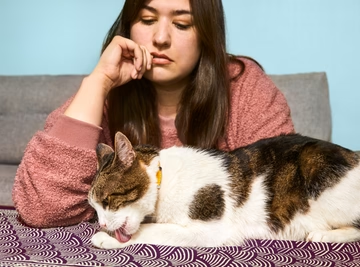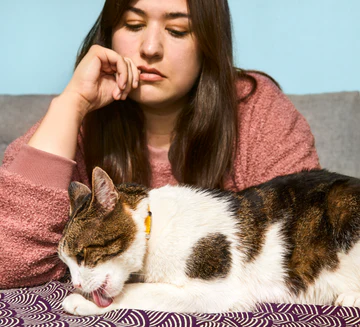Sooth your cat's arthritis and joint pain from home
Video chat with a vet today to get prescription medication mailed to you. Plans start at $11/mo.

- Same-day, night & weekend appointments
- Unlimited video calls & messaging
- Prescriptions delivered free to you
- Our vets can treat 92% of joint issues

What to know about cat joint pain and arthritis
Learn how to spot arthritis in your cat and relieve their pain.


What is cat arthritis?
What is cat arthritis?
Feline osteoarthritis, or cat arthritis, is a common degenerative joint disease that involves the breaking down of the cartilage and bones of the joints. The loss of protective tissues causes bones to rub against one another, resulting in inflammation and pain. The condition can get progressively worse over time, resulting in chronic pain and a loss of quality of life, but there are treatments to minimize discomfort.
What are the signs of arthritis in cats?
What are the signs of arthritis in cats?
Arthritis symptoms in cats can vary and depend on the joint affected along with the amount of degeneration. Cats are good at hiding their pain, but things to look out for include stiffness, limping, irritation, poor grooming, behavior and mood changes, and a reluctance to jump on and off objects. If you notice any of these symptoms, schedule an online vet visit with Dutch to consult with a licensed veterinarian.
What causes cat arthritis?
What causes cat arthritis?
Scientists don’t know the exact cause of feline arthritis, but age, weight, injuries, and genetics all play a role in the degeneration of the tissues and bones located in the joints. Some breeds have a higher risk of arthritis, including Maine Coon, Persian, Siamese, Abyssinian, Devon Rex, and Scottish Folds.
What’s the treatment for cat arthritis?
What’s the treatment for cat arthritis?
Treatment depends on the physical condition of your cat and how much pain they have. Medications to relieve pain and inflammation, dietary supplements (like glucosamine and chondroitin and omega-3 fatty acids), and modifications to their living environment may improve your cat’s comfort level. If your cat is overweight, a diet and weight loss plan can help. Laser therapy, physical rehabilitation, and (in rare cases) surgery are other treatment options depending on your cat’s needs.
How Dutch works
-
Pick a plan and become a member
-
Schedule a video call with a licensed vet
-
Order the prescriptions the vet recommends
Frequently asked questions
What can I use Dutch for?
What can I use Dutch for?
With Dutch, you’re never alone when it comes to your pet’s health. Whether your pet needs care or you just have a question, our compassionate and knowledgeable vets are always happy to help.
Here are some ways you can use Dutch:
- Care & prescriptions for over 150 issues
- Behavioral health, nutrition, and exercise advice
- Puppy, kitten, and new pet parent advice
- Preventive care plans
- Night and weekend vet care
- Second opinions & follow-up care after in-person visits
- Advice on whether you need to go to the ER or urgent care
- Vet care when you’re traveling
- Easy prescription refills
- Longevity treatment plans
- Answers to non-urgent questions
What is a visit with Dutch like?
What is a visit with Dutch like?
When booking a video call with a vet, you'll be asked a few questions about your pet’s health issue. Depending on the issue, you may also be asked to fill out a longer questionnaire about their symptoms and share photographs of them so our veterinarians can better understand what’s going on. You’ll then pick an appointment time that works best for you.
During your video call, one of our licensed veterinarians will talk to you about the symptoms your pet is experiencing, ask you questions, review your pet’s medical history if you’ve provided it, and answer any questions you have. The vet will ask to see your pet and their environment. And they may ask you to perform some simple checks on them if needed.
After your video call, the vet will send you a message with a custom treatment plan to help your pet feel better, including a link to buy any recommended prescription or over-the-counter medications. Place your order and we’ll ship it free.
How do I know if you can treat my pet?
How do I know if you can treat my pet?
Our vets can provide care and prescriptions for more than 150 issues — and over 90% of cases can be treated virtually.
The vet can diagnose your pet based on your description of their symptoms, their medical history, seeing them during your video call, and, if needed, through uploaded photos and videos. They may ask you to do a few simple checks during the call. We also offer a number of at-home lab test kits for dogs and cats.
The health and safety of pets is our top priority. In the rare case that a vet determines a pet needs to go to a local clinic, they’ll provide a referral and offer advice on how to care for them until they can be seen.
Some things that require in-person care include emergencies, wounds that need stitches, and issues that require blood work, imaging (X-rays or ultrasounds), or surgery.
Our vets are always available for second opinions and follow-up care after in-person vet visits — so you don’t have to navigate health issues alone.
How much will it cost for Dutch to treat my pet?
How much will it cost for Dutch to treat my pet?
Our memberships are designed to make your pet’s care as easy and affordable as possible. Here’s how your costs will break down:
Membership: You can choose to pay the total price upfront or in 4 installments. All memberships include unlimited care for up to 5 pets at no extra cost.
Vet calls and messaging: No cost — video chat and message with vets as often as you need for free.
Medication: The price will vary depending on your pet’s needs. To keep your costs down, we offer a price-match guarantee, free standard shipping, $25 off your first product order, and 20% off your first flea & tick order.




